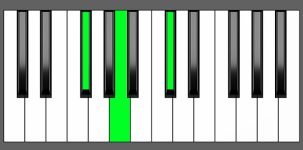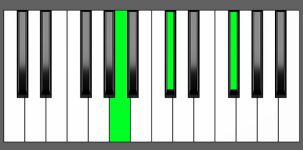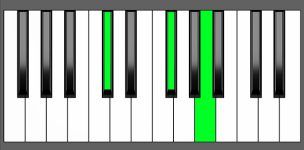Piano Diagram of Gb min in Root Position

The Gb minor chord is the minor triad built upon the G-flat key. It is built by combining the Root note (Gb), the minor 3rd (Bbb, which is equivalent to A), and the 5th (Db) notes from the Gb minor scale.
Structure of Gb minor
Notes |
|---|
| Gb, Bbb, Db |
Intervals |
|---|
| R, m3, 5 |
Fingers Position
Left Hand |
|---|
| 5, 3, 1
4, 2, 1 |
Right Hand |
|---|
| 1, 2, 5
1, 2, 4 |
Gb minor Chord Inversions
The Gb minor chord has a total of 2 inversions:
| Root Position: | Gb | Bbb | Db |
| 1st Inversion: | Bbb | Db | Gb |
| 2nd Inversion: | Db | Gb | Bbb |
Piano Keyboard Diagrams
Music Theory and Harmony of Gb minor
What are Minor Chords?
Minor chords are one of the two most important types of chords in music, along with the major chord. Minor chords are triads that have a slightly different sound from major chords. They have a darker and more melancholic sound compared to major chords, which have a brighter and more uplifting sound. The difference lies in the 3rd note of the chord – minor chords use a minor 3rd while major chords use a major 3rd.
Despite their darker sound, minor chords are still considered stable and consonant chords. This means that they do not create a sense of tension or dissonance that requires resolution, unlike some other types of chords such as dominant 7th chords or diminished chords.
Building the Gb minor Chord: Different Approaches
Starting from the G-flat Major scale
A minor chord is made up of three notes: Root, minor 3rd, and 5th of a minor scale. However, since G-flat minor is a theoretical key, it’s not commonly used due to the many accidentals involved (9 flats). Instead, it’s easier to use the Gb major scale, as it better illustrates the relationship between intervals and their qualities and have less flats compared to the minor scale.


To build a minor chord, you can apply the formula R, m3, 5 using these step-by-step instructions:
- Begin with the Root note, Gb.
- To select the minor 3rd interval of a note, you need to count three half steps up from that note. Alternatively, you could find the 3rd note on the major scale (which for Gb would be Bb) and then lower it down by a half step to get Bbb, which is the minor 3rd interval of Gb.
- Finally, add the 5th interval, which is Db.
This formula can be applied to any major scale to create a minor chord with a different root note.
by Combining Intervals
A minor chord is created by combining two specific intervals: a minor 3rd and a major 3rd.
m3 + 3 = minor Chord
To form a Gb minor chord, begin with the root note Gb and add a minor 3rd interval. This interval consists of three half-steps, so count up three half-steps from the root note Gb to find Bbb.
Next, add a major 3rd interval to Bbb. This interval consists of four half-steps, so count up four half-steps from Bbb to find Db.
These three notes – Gb, Bbb, and Db – together create the Gb minor chord. So, the Gb minor chord is made up of a minor 3rd interval between Gb and Bbb, and a major 3rd interval between Bbb and Db.
It’s worth noting that this method is not the easiest way to create a minor chord, but it’s a commonly used approach.
Gb min in Chord Progressions
G-flat minor is a theoretical key as it has two double-flats and five flats in its key signature, making it less commonly used due to the high number of accidentals involved. The same applies to all the keys where is present a Gb minor chord. It is more practical to refer to the enharmonic equivalent keys and use F# minor in place of Gb minor.
on Natural minor Scales
| Minor Scales | i | ii | III | iv | v | VI | VII |
|---|---|---|---|---|---|---|---|
| Gb = F# | F#m = Gbm | G# dim | A Maj | B min | C# min | D Maj | E Maj |
| Db = C# | C# min | D# dim | E Maj | F#m = Gbm | G# min | A Maj7 | B Maj |
| Cb = B | B min | C# dim | D Maj | E min | F#m = Gbm | G Maj | A Maj |
- Tonic chord in F# minor as F# min
- Subdominant chord in C# minor as F# min
- Dominant chord in B minor as F# min
on Major Scales
| Major Scales | I | ii | iii | IV | V | vi | vii |
|---|---|---|---|---|---|---|---|
| Fb = E | E Maj | F#m = Gbm | G# min | A Maj | B Maj | C# min | D# dim |
| Ebb = D | D Maj | E min | F#m = Gbm | G Maj | A Maj | B min | C# dim |
| Bbb = A | A Maj | B min | C# min | D Maj | E Maj | F#m = Gbm | G# dim |
- Supertonic chord in F Major as F# min
- Mediant chord in Eb Major as F# min
- Submediant chord in Bb Major as F# min
Gb min in Gb Minor
Check F# min in F# Major
Gb min in Db Minor
Check F# min in C# Major
Gb min in Cb Minor
Check F# min in B Major
Gb min in Fb Major
Check F# min in E Major
Gb min in Ebb Major
Check F# min in D Major
Gb min in Bbb Major
Check F# min in A Major
Alternative Names for Gb minor
- Gb-
- Gbm
- Solb-
- Solb m
- Gb min
- Gb-moll
- Solb min
- Gb minor
- G-flat minor


